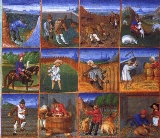
English Medieval fashion
Encyclopedia

England in the Middle Ages
England in the Middle Ages concerns the history of England during the Medieval period — from the end of Roman rule in Britain through to the Early Modern period...
in England
England
England is a country that is part of the United Kingdom. It shares land borders with Scotland to the north and Wales to the west; the Irish Sea is to the north west, the Celtic Sea to the south west, with the North Sea to the east and the English Channel to the south separating it from continental...
is classified as the time between the fall of the Roman Empire
Roman Empire
The Roman Empire was the post-Republican period of the ancient Roman civilization, characterised by an autocratic form of government and large territorial holdings in Europe and around the Mediterranean....
to the beginning of the Renaissance
Renaissance
The Renaissance was a cultural movement that spanned roughly the 14th to the 17th century, beginning in Italy in the Late Middle Ages and later spreading to the rest of Europe. The term is also used more loosely to refer to the historical era, but since the changes of the Renaissance were not...
, ranging from the years AD 449–1500. For the Anglo-Saxons
Anglo-Saxons
Anglo-Saxon is a term used by historians to designate the Germanic tribes who invaded and settled the south and east of Great Britain beginning in the early 5th century AD, and the period from their creation of the English nation to the Norman conquest. The Anglo-Saxon Era denotes the period of...
, Anglo-Danes, Normans
Normans
The Normans were the people who gave their name to Normandy, a region in northern France. They were descended from Norse Viking conquerors of the territory and the native population of Frankish and Gallo-Roman stock...
and Britons
Britons (historical)
The Britons were the Celtic people culturally dominating Great Britain from the Iron Age through the Early Middle Ages. They spoke the Insular Celtic language known as British or Brythonic...
, clothing during the medieval era differed widely for men and women as well as for the social hierarchy. During this period men's clothing changed much more rapidly than women's styles; and both the men and women of lower social classes continued to wear styles from previous centuries until their garments were in such disrepair that they needed to be replaced entirely. In addition to this division, sumptuary laws also divided social classes by regulating the colours and styles these various ranks were permitted to wear.
1300–1500
The majority of records on women’s fashion during the medieval period come from the mid-fourteenth century onwards. Around the year 1340 there was a change in women’s clothing, to tighter-fitting garments, lower necklines, and more curvaceous silhouettes; “tight lacing was used on women's clothes to create a form fitting shape which, girdled at the hips, created a long-waisted appearance”. Clothing was over-lapped and tightly bound; “The female chest was frequently exposed, yet the true structure of the female body was visually distorted…”. The corsetCorset
A corset is a garment worn to hold and shape the torso into a desired shape for aesthetic or medical purposes...
became a staple in a woman’s wardrobe, and the open surcoat
Surcoat
A surcoat was an outer garment commonly worn in the Middle Ages by both men and women. It can either refer to a coat worn over other garments or the outer garment of a person...
, a garment with an open bodice and a skirt that trailed to the ground, became “one of the most elegant inventions of the Middle Ages…”. In fact, by the end of the 14th century, the gown
Gown
A gown is a loose outer garment from knee- to full-length worn by men and women in Europe from the early Middle Ages to the 17th century ; later, gown was applied to any woman's garment consisting of a bodice and attached skirt.A long, loosely-fitted gown called a Banyan was worn by men in the 18th...
had replaced all garment items aside from the surcoat.
The basic garments for women consisted of the smock, hose
Hose (clothing)
Hose are any of various styles of men's clothing for the legs and lower body, worn from the Middle Ages through the 17th century, when the term fell out of use in favor of breeches and stockings. The old plural form of "hose" was hosen...
, kirtle
Kirtle
A kirtle is a tunic-like garment worn by men and women in the Middle Ages or, later, a one-piece garment worn by women from the later Middle Ages into the Baroque period...
, gown, surcoat, girdle
Girdle
A girdle is a garment that encircles the lower torso, perhaps extending below the hips, and worn often for support. The word girdle originally meant a belt. In modern English, the term girdle is most commonly used for a form of women's foundation wear that replaced the corset in popularity...
, cape
Cape
Cape can be used to describe any sleeveless outer garment, such as a poncho, but usually it is a long garment that covers only the back half of the wearer, fastening around the neck. They were common in medieval Europe, especially when combined with a hood in the chaperon, and have had periodic...
, hood
Hood (headgear)
A hood is a kind of headgear that covers most of the head and neck and sometimes the face. They may be worn for protection from the environment, for fashion, as a form of traditional dress or uniform, to prevent the wearer from seeing or to prevent the wearer from being identified.-History and...
, and bonnet
Bonnet (headgear)
Bonnets are a variety of headgear for both sexes, which have in common only the absence of a brim. Bonnet derives from the same word in French, where it originally indicated a type of material...
. Each piece had designated colours and fabrics, for example “Materials used in the middle ages were woolen cloth, fur
Fur clothing
Fur clothing is clothing made of the fur of animals. Fur is one of the oldest forms of clothing; thought to have been widely used as hominids first expanded outside of Africa. Some view fur as luxurious and warm; others reject it due to moral beliefs...
, linen
Linen
Linen is a textile made from the fibers of the flax plant, Linum usitatissimum. Linen is labor-intensive to manufacture, but when it is made into garments, it is valued for its exceptional coolness and freshness in hot weather....
, cambric
Cambric
Cambric, pronounced , "one of the finest and most dense species of the cloth manufacture", is a lightweight plain weave cloth, originally from Cambrai, woven in greige, then bleached and piece-dyed, often glazed or calendered. Initially made from flax, then cotton in the 19th century, it is also...
, silk
Silk
Silk is a natural protein fiber, some forms of which can be woven into textiles. The best-known type of silk is obtained from the cocoons of the larvae of the mulberry silkworm Bombyx mori reared in captivity...
, and the cloth of silver or gold…the richer Middle Age women would wear more expensive materials such as silk, or linen”. The development of the skirt
Skirt
A skirt is a tube- or cone-shaped garment that hangs from the waist and covers all or part of the legs.In the western world, skirts are usually considered women's clothing. However, there are exceptions...
was significant for women’s medieval clothing, “The more fashionable would wear very large or wide skirts”. The petticoat
Petticoat
A petticoat or underskirt is an article of clothing for women; specifically an undergarment to be worn under a skirt or a dress. The petticoat is a separate garment hanging from the waist ....
made way for the skirt, which quickly became a popular garment because it “wraps rather than enclosing, touches without grasping, brushes without clasping, coasts, caresses, skims, strokes”.
The headdress, in various forms culminating in the hennin
Hennin
The hennin was a headdress in the shape of a cone or "steeple", or truncated cone worn in the late Middle Ages by European women of the nobility. They were most common in Burgundy and France, but also elsewhere, especially at the English courts, and in Northern Europe, Hungary and Poland. They...
was an important element in women's dress, often complicated arrangements of hair and fabric, sometimes including veil
Veil
A veil is an article of clothing, worn almost exclusively by women, that is intended to cover some part of the head or face.One view is that as a religious item, it is intended to show honor to an object or space...
s over the face or hanging behind the head. The importation of luxurious fabrics increased over the period, and their use widened somewhat spread from the top of the elite downwards, but clothing remained very expensive and relatively few items were owned except by the very wealthy.asu
Medieval clothes provided information about the status of the person wearing them.
Common attire
Early Anglo-SaxonAnglo-Saxon
Anglo-Saxon may refer to:* Anglo-Saxons, a group that invaded Britain** Old English, their language** Anglo-Saxon England, their history, one of various ships* White Anglo-Saxon Protestant, an ethnicity* Anglo-Saxon economy, modern macroeconomic term...
regardless of social rank wore a cloak
Cloak
A cloak is a type of loose garment that is worn over indoor clothing and serves the same purpose as an overcoat; it protects the wearer from the cold, rain or wind for example, or it may form part of a fashionable outfit or uniform. Cloaks are as old as human history; there has nearly always been...
, tunic
Tunic
A tunic is any of several types of clothing for the body, of various lengths reaching from the shoulders to somewhere between the hips and the ankles...
, trousers
Trousers
Trousers are an item of clothing worn on the lower part of the body from the waist to the ankles, covering both legs separately...
, leggings
Leggings
Leggings are a type of fitted clothing covering the legs, which can be worn by both men and women.Originally leggings were two separate garments, one for each leg....
, and accessories. The short, fur-lined cloak was designed so that the skin of the animal faced outward and the fur brushed against the undergarments. However, woolen cloaks have also been found. The garment opened either at the front or at the right shoulder. A single brooch
Brooch
A brooch ; also known in ancient times as a fibula; is a decorative jewelry item designed to be attached to garments. It is usually made of metal, often silver or gold but sometimes bronze or some other material...
, usually circular in shape, fastened the square or rectangular cloak. Other means of fastening the cloth together included tying, lacing, or using a clasp, often made of natural materials such as thorn, bones, wood, or horns. The less prosperous wore woolen cloaks.
The tunic ended between the hip and the knee and had either long or short sleeves. Clasps were not needed to hold the tunic together because when pulled over the head it would sit snuggly around the neck without the use of lacing or ties, indicating that the garment was one continuous piece. A belt
Belt (clothing)
A belt is a flexible band or strap, typically made of leather or heavy cloth, and worn around the waist. A belt supports trousers or other articles of clothing.-History:...
or girdle
Girdle
A girdle is a garment that encircles the lower torso, perhaps extending below the hips, and worn often for support. The word girdle originally meant a belt. In modern English, the term girdle is most commonly used for a form of women's foundation wear that replaced the corset in popularity...
was usually worn with the tunic and might have had a buckle, and, as Owen-Crocker states, “pouched over the belt”. Multiple tunics were worn at once so that the lower one, often short sleeved, served as a shirt.
Trousers, traditionally worn under a short tunic or with a small cloak
Cloak
A cloak is a type of loose garment that is worn over indoor clothing and serves the same purpose as an overcoat; it protects the wearer from the cold, rain or wind for example, or it may form part of a fashionable outfit or uniform. Cloaks are as old as human history; there has nearly always been...
, were ankle length. If loose, the excess material was bunched around the waist and, as Owen-Crocker describes, “hung in folds around the legs”. Garters or leggings accompanied narrow trousers. Pieces of fabric attached to the trousers forming belt loops so that the garment could be at held in place at the waist by a belt.
Leggings, usually worn in pairs, acted as additional protection for the legs. The first legging, referred to as the legging proper or stocking
Stocking
A stocking, , is a close-fitting, variously elastic garment covering the foot and lower part of the leg. Stockings vary in color, design and transparency...
, consisted of woven fabric or leather. The second was simply a piece of fabric used to tie on the leggings or, if worn around the shin or foot, provided warmth and protection. The lower caste wore leggings made of ripped or cut cloth from old clothes, blankets, or bags whereas the upper caste had custom made leggings. The very rich people sometimes wore jewels.
Belts worn at the hips were more of a necessity rather than a luxury. Buckles were common and most faced the front; however others have been found to face both sides or even, in some cases, were placed at the back of the body. Owen-Crocker mentions that “belt ornaments and tags” dangled from the belts of the Anglo-Saxons in addition to everyday equipment. Beads occasionally acted as alternatives, although not often. Leather belts, often decorated, were the most common. Intricate belts, worn to be seen, were placed in view while an additional belt or girdle held the trouser in place under the tunic.
The Anglo-Saxons usually covered their bare feet, except when working. Shoe
Shoe
A shoe is an item of footwear intended to protect and comfort the human foot while doing various activities. Shoes are also used as an item of decoration. The design of shoes has varied enormously through time and from culture to culture, with appearance originally being tied to function...
s were made of leather and secured with straps. Hat
Hat
A hat is a head covering. It can be worn for protection against the elements, for ceremonial or religious reasons, for safety, or as a fashion accessory. In the past, hats were an indicator of social status...
s and hoods were commonly worn as were glove
Glove
A glove is a garment covering the hand. Gloves have separate sheaths or openings for each finger and the thumb; if there is an opening but no covering sheath for each finger they are called "fingerless gloves". Fingerless gloves with one large opening rather than individual openings for each...
s and mittens.
General attire
Clothing of the seventh through the 9th centuries was similar to that of previous centuries and again all classes generally wore the same clothing, although distinctions among the social hierarchy began to become more noticeable through ornamented garments. These common pieces consisted of tunics, cloaks, jacketJacket
A jacket is a hip- or waist-length garment for the upper body. A jacket typically has sleeves, and fastens in the front. A jacket is generally lighter, tighter-fitting, and less insulating than a coat, which is outerwear...
s, pants, and shoes. As in the 5th and 6th centuries, a linen shirt acted as an undergarment. Men generally wore a knee-length linen or woolen tunic, depending on the season, over their shirts. The sleeves of the tunic were long and close fitting and excess material was pushed up the arm from the elbow to the wrist so that “rolls” were formed in the material. The neck of the tunic opened as did both sides and a belt or girdle was usually worn around the waist. According to rank, embellishments adorned the collar of the tunic, waist, or border and for peasants, or the working classes, a plain tunic with sleeves was generally worn. Examples of these decorations included, as Planché states, “gold and silver chains and crosses, bracelets of gold, silver or ivory, golden and jeweled belts, strings of amber and other beads, rings, brooches, [and] buckles”. The nobility tended to wear longer tunics than the lower social classes.
A cloak, worn over the tunic, fastened on either the breast or a shoulder with the assistance of a brooch. Once in place, the brooch was left attached to the garment so that the cloak was slipped over the head. The cloak, knee-length and rectangular in shape, was fastened so that it appeared to be pleat
Pleat
A pleat is a type of fold formed by doubling fabric back upon itself and securing it in place. It is commonly used in clothing and upholstery to gather a wide piece of fabric to a narrower circumference....
ed or folded. Hoods and collar
Collar (clothing)
In clothing, a collar is the part of a shirt, dress, coat or blouse that fastens around or frames the neck. Among clothing construction professionals, a collar is differentiated from other necklines such as revers and lapels, by being made from a separate piece of fabric, rather than a folded or...
s began to appear in the 9th century, and around the same time, the cloak began to be curbed by the same belt that was worn over the tunic. The wrap-over coat
Coat (clothing)
A coat is a long garment worn by both men and women, for warmth or fashion. Coats typically have long sleeves and are open down the front, closing by means of buttons, zippers, hook-and-loop fasteners, toggles, a belt, or a combination of some of these...
also made an appearance during this era. This knee-length coat wrapped over the front of the body. Its sleeves were, as Owen-Crocker says, “deep, [with] decorated cuffs which [were] mostly straight”. For the lower classes, this coat tended to be plainer than that of the nobility.
The waistcoat or jacket appeared during this time as well. For those who could afford it, the jacket was made of fur while less costly ones were made of linen. This jacket was waist-length and tended to have a broad collar.
The trousers in this era were shortened to mid thigh and stockings, made of leather, met them there. Atop the stockings, rounds of cloth, linen, or leather were worn which started at the ankle and ended just below the knee, as Planché explains, in “close rolls… or crisscrossing each other sandal-wise”. Planché states that socks began to be worn over the stocking and were “banded at the top”. Shoes of this era, painted black, had an opening down the instep and were secured with straps. Anglo-Saxons appreciated shoes and thus all classes wore them. Common colours for this era consisted of red, blue, and green.
King
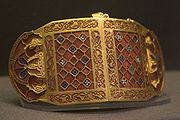
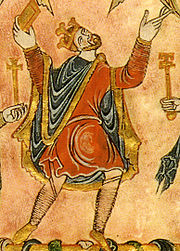
Military
Well-armed Anglo-Saxon soldiers wore wrap-over coats decorated like chain mail with sleeves that narrowed at the wrists. Owen-Crocker explains that the belts of commanders were elaborate, wide, and fastened by “a narrow strap which was riveted to the broad belt and passed through a buckle which was much narrower than the belt itself” leaving the end of the belt to hang down. Also attached to the belt were pouches which allowed soldiers to carry their weapons. In the 9th and 10th centuries, military attire did not differ much from that of civil attire. The only changes were in the form of short linen tunics with metal collars and the addition of a sword, spear, shield, and helmet. Weapons and clothes fittings worn on the battlefield were highly decorated with jewellery techniques, as seen in the discoveries at Sutton HooSutton Hoo
Sutton Hoo, near to Woodbridge, in the English county of Suffolk, is the site of two 6th and early 7th century cemeteries. One contained an undisturbed ship burial including a wealth of Anglo-Saxon artefacts of outstanding art-historical and archaeological significance, now held in the British...
and in the Staffordshire Hoard
Staffordshire Hoard
The Staffordshire Hoard is the largest hoard of Anglo-Saxon gold and silver metalwork . Discovered in a field near the village of Hammerwich, near Lichfield, in Staffordshire, England on 5 July 2009, it consists of some 3,500 items that are nearly all martial in character...
; the concept of parade wear did not exist for the Anglo-Saxons.
Clergy
Planché asserts that the clergy of the 9th and 10th centuries dressed similarly to the laityLaity
In religious organizations, the laity comprises all people who are not in the clergy. A person who is a member of a religious order who is not ordained legitimate clergy is considered as a member of the laity, even though they are members of a religious order .In the past in Christian cultures, the...
, except when saying mass
Mass
Mass can be defined as a quantitive measure of the resistance an object has to change in its velocity.In physics, mass commonly refers to any of the following three properties of matter, which have been shown experimentally to be equivalent:...
. Beginning in the later 8th century, the clergy were forbidden to wear bright colours or expensive or valuable fabrics. Owen-Crocker mentions that their twill cloaks were generally shorter than those of the laity, reaching just below the waist, and Planché adds, that they wore linen stocking.
General attire
Planché explains that in the 11th century, shortened tunics became popular as did shorter hair styles and beard lengths. Piercings also became fashionable for men as did golden bracelets. During this era men continued to wear tunics, cloaks, and trousers which did not vary much from their previous counterparts. CoifCoif
A coif is a close fitting cap that covers the top, back, and sides of the head.- History :Coifs were worn by all classes in England and Scotland from the Middle Ages to the early seventeenth century .Tudor and earlier coifs are usually made of unadorned white linen and tied under...
s became popular head-coverings and appeared to be “flat round cap[s]”. Long stockings, with feet attached, were in style, and leg bandages and shoes continued to be worn. Short boots, those only extending to the ankle, were introduced in the latter part of the century.
King
Not much is mentioned regarding the attire of the king in this era other than he wore a mail tunic. However, it is known that the nobles of the time continued to wear long, ankle-length tunics. Their cloaks, also referred to as mantels, were lavish and elegant and cords and tassels were attached to adorn the mantle.Military attire
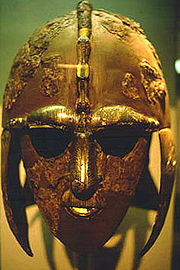
Cowl
This article is about the garment used by monks and nuns. For other uses, see Cowl or Cowling .The cowl is an item of clothing consisting of a long, hooded garment with wide sleeves. Originally it may have referred simply to the hooded portion of a cloak...
, which was covered in rings, emerged during this time and was worn under the helmet, which also had a new addition, the nose piece. The ringed knee-length tunic was slit in the front and back to allow for more comfortable riding. The length of the trousers became shorter. “Mascled armor” began to replace the traditional ringed armory. These new iron pieces were assembled to look like mesh or nets but a combination of the two patterns have been found to be used. Another variation included covering the body in rings and removing the sleeves from the tunic. Planché mentions that a “square pectoral” was added to the breast of the armor as added protection and were “quilted or covered with rings”. A yellow border was added to the pectorals, sleeves, and skirts. Shields had two new adjustments: one strap looped around the arm while a second strap circled around the neck, allowing the soldier the use of both his hands.
Clergy
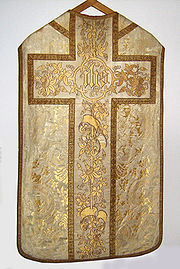
Bonnet (headgear)
Bonnets are a variety of headgear for both sexes, which have in common only the absence of a brim. Bonnet derives from the same word in French, where it originally indicated a type of material...
, which, according to Planché, were “slightly sinking in the centre, with the pendent ornaments of the mitre
Mitre
The mitre , also spelled miter, is a type of headwear now known as the traditional, ceremonial head-dress of bishops and certain abbots in the Roman Catholic Church, as well as in the Anglican Communion, some Lutheran churches, and also bishops and certain other clergy in the Eastern Orthodox...
attached to the side of it”. Other garments included the chasuble
Chasuble
The chasuble is the outermost liturgical vestment worn by clergy for the celebration of the Eucharist in Western-tradition Christian Churches that use full vestments, primarily in the Roman Catholic, Anglican and Lutheran churches, as well as in some parts of the United Methodist Church...
, the outermost liturgical vestment, which retained its shape, and the dalmatic
Dalmatic
The dalmatic is a long wide-sleeved tunic, which serves as a liturgical vestment in the Roman Catholic, Lutheran, Anglican, and United Methodist Churches, which is sometimes worn by a deacon at the Mass or other services. Although infrequent, it may also be worn by bishops above the alb and below...
s, a tunic like vestment with large, bell shaped sleeves, which tended to be arched on the sides. The pastoral staff
Crosier
A crosier is the stylized staff of office carried by high-ranking Catholic, Eastern Orthodox, Anglican, and some Lutheran and Pentecostal prelates...
was generally found to be plain in colour and ornamentation.
General attire
The 12th century brought changes in the civil attire for the inhabitants of the British Isles. The tunic was now close fitting with a long skirt. There was, as C. Cunnington describes, a “slit up in front to the thigh level” and the sleeves, now close fitting, were “bell-shaped” at the wrist or, the “lower portion [hung] to form a pendulous cuff which might be rolled up for action”. Peasants wore tunics which were shorter and the sleeves were “tubular…[and] rolled back”. The tunic could be worn with or without the girdle, which now carried the sword. Neck lines were either diagonal, from the neck moving across the chest, or horizontal, from the neck to the shoulder. The super tunic, worn with a girdle, was occasionally worn alone but was never paired with the aforementioned tunic. The sleeves of this super tunic had, as C. Cunnington states, “pendulous cuffs,” which were uncommon, or were “loose and often elbow-length only”. The super tunic was occasionally lined with fur.The cloak and mantle, a cloak resembling a loose cape, were fastened either with a brooch or clasp, or as C. Cunnington describes, “the corner of the neck edge on one side was pulled through a ring sewn to the opposite corner, and then knotted to keep in position”. For the rich, the cloak was lined with fur and for all classes beneath, the cloak was hooded and made of animal hide, with the hair facing out.
General attire
For the first half of the 13th century, linen braies were worn and then shortened to the knee in the second half of the century, which then became drawers or undergarments. Short stockings ended just below the knee and the border was occasionally decorated. Longer stockings, mid thigh length, could also be worn and, as C. Cunnington depicts, were “shaped to fit the leg, widening above the knee so that they could be pulled up over the braies”. The stockings and girdle were tied together at a point in the top front of the stocking by which to keep it in place. Some stockings had stirrups, whole feet, or no feet. For hosiery, made of wool or leather, a “thin leather sole was attached” so that shoes would not need to be worn. Leg wear during the 12th century tended to be brightly coloured and stripes were popular.All classes of men during the 12th century wore shoes or boots. Shoes, as C. Cunnington describes, were “open over the foot and fastened in front of the ankle with a strap secured by a brooch or buckle”.

Separate hoods also made an appearance. They were loose with, as C. Cunnington describes, a “pointed cowl” and were attached to a robe stretching to the shoulders. The cape was usually a single piece of material and thus had to be put on over the head. C. Cunnington states that the “pointed Phrygian cap,” or the “small, round cap with stalk or with a rolled brim and with or without the stalk” or the “stalked soft cap, resembling a beret” were worn. Travelers wore “hats with large brims and low crowns…over the hood” which tied under the chin (. Small hats with round crowns and, C. Cunnington says, “turned-down brim, decorated with a knob instead of a stalk” were also worn, as were coifs, which was a “close fitting plain linen bonnet which covered the ears and confined the hair” and tied under the chin. The coif could be worn with other hats or hoods.
Accessories for 12th century English men became more decorated. The girdle, mid century, became more elaborate in its ornamentation and in the latter half of the century, was, “tied like a sash in front with hanging ends” or, if “long and elaborate, was fastened with ornamental buckles” as C. Cunnington depicts. Wallets and purses, in the early half of the century, were hung from the girdle or the breech girdle and in the latter half were placed under the tunic, out of sight. During this era gloves became fashionable for the nobility, although they were seldom worn. Rings, brooches, buckles, clasps, and “ornamental fillets of gold and silver” C. Cunnington says were worn by the ruling classes. Wool, linen, and silk continued to be used, as was leather, which the peasants used for tunics and mantle and left the hair on facing outward. Garments were also embroidered during this era.
Men continued to wear both short and long tunics with a girdle; however the slit up the front was removed. A new style was introduced in this era in which the sleeves and body were cut from one piece of material. A wide armhole, which extended to the waist, was left open and the sleeves were cut in order to, as C. Cunnington states, “slope off to a narrow tight cuff at the wrist”. The super tunic of the 11th century continued to be worn by the less fashionable, the lower classes of society, and the girdle was optional. Five new styles of the super tunic were introduced in this era. The first consisted of a front and back panel which extended from the shoulders to the calf level. The two panels were sewn together or clasped together near the waist, where they were met by a slit up the front. The neck opening was large so that the tunic could be put on over the head and a belt was not usually worn with this tunic. The second new style was more “voluminous” as C. Cunnington describes, and hung in folds to a length between the knees and the ankles. The sleeves gathered at the shoulders and extended beyond the hands. A vertical slit was cut in the upper arm of the sleeve to allow unrestrained movement. This garment, like the previous, was puton over the head and a hood was often attached. The third style was much looser than the previous ones. The sleeves could extended to just below the elbow or could be worn short and wide. A buckled belt was optional. The fourth super tunic, or garnache, was knee length and the material was cut wide at the shoulders to allow the material to “fall down on each side, predicting cape-like sleeves,” as C. Cunnington describes. The sides of this tunic could be clasped at the waist, sewn from the waist to the hem, or left open and was traditionally beltless. The last style was simply sleeveless and worn with a belt.
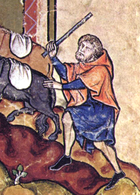
Fitchets, resembling modern day pockets, also appeared in the 13th century. Vertical slits were cut in the super tunic, which did not have any side openings, to allow access to purse or keys slung from the girdle of the tunic.
Men’s headwear of the 13th century, as C. Cunnington illustrates, consisted of the hood, which was sometimes buttoned, and stalked round caps and large rimmed traveling hats, both seen in the previous century. New to this era were hats with “round brim[s] turned up at the back which could be worn reversed with the turn-up in front”. Hats with round crowns also made an appearance and were sometimes found with a “knob on the crown” or with a “moderate brim with a downward slope or a rolled brim”. The coif continued to be worn much more frequently.
During this era garments such as cloaks, mantles, and stockings remained unchanged. However, during this era, stockings were sometimes tied with narrow strips of material below the knee to hold the stocking in place. Leg bandages for the nobility became popular which criss-crossed and extended above the knee.
Shoes during this era were designed so that each shoe was cut explicitly for an individual’s foot. Shoes were plain, and most were closed around the ankle and were laced or buckled along the inner side of the foot. Other shoes exposed the top of the foot and either stretched high behind the ankle or were clasped near the ankle by an instep strap. Boots, as C. Cunnington describes, were briefly coloured along the top, had a much looser fit, and were barely extended to the calf. Calthrop adds that boots were “turned over a little at the top”.
Men’s accessories were similar to those of the 11th century. Gloves continued to be worn by the nobility and could be long, stretching to the elbow, or short, wrist length, and began to be decorated, C. Cunnington explains, “with a broad strip of gold embroidery down the back as far as the knuckles”. By the end of the century, gloves were more widely worn and were ornamented with silver or gilded
Gilding
The term gilding covers a number of decorative techniques for applying fine gold leaf or powder to solid surfaces such as wood, stone, or metal to give a thin coating of gold. A gilded object is described as "gilt"...
buttons. Calthrop also includes that long hair and neatly trimmed beards were in style for 13th century men.
General Attire

The gipon, also called a pourpoint or doublet, emerged during the 14th century. It replaced the tunic and was knee length and close-fitting. The gipon was not designed with any folds or gathers as the tunic was. The sleeves were long and tight and the neck was low. The bodice was padded and the garment was either buttoned or laced down the front, but for the lower classes it was only buttoned to the waist. The gipon was traditionally worn over a shirt and if worn with an outer garment, a belt was not worn. At the end of the century, the gipon was shortened to above the mid thigh and was worn with a belt at hip level
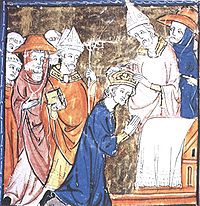
Men’s stockings of the 14th century were lengthened and tied to the gipon, so that it was hidden under the skirt. Shorter stockings were tied to garters with stripes of wool or linen. Shorter boots and shoes also become fashionable. Woolen soles were added to shoes as were straps.
The hood continued to be worn by men during this era. However, its shape changed. The pointed cowl was lengthened as P. Cunnington describes, “into a long streamer..and from this another head-dress was made which was made in the form of a turban with a fall-over flap made from the hood cape”. Stalked caps remained popular and small hats with close, turned up brims emerged. Toward the end of the century men began putting feathers in their hats for decoration.
Gloves spread amongst the social hierarchy so that even those of the working class were wearing them in the 14th century. For this class, only the thumb and two sections existed for the fingers.
Sumptuary Laws
The Sumptuary Laws played a large role in dividing the classes as they were used to "ensure that a specific class structure was maintained." These laws served to regulate the "dress of various classes".The lower class in the Middle Ages often did not have clothing that the nobles had access to. Poor men and women working in the fields or wet or muddy conditions often went barefoot. Upper and middle class women wore three garments and the third garment was either a surcoat
Surcoat
A surcoat was an outer garment commonly worn in the Middle Ages by both men and women. It can either refer to a coat worn over other garments or the outer garment of a person...
, blait, or coathardie. These were often lavish garments, depending on the wealth of the person wearing them, and could have trimmings in fur
Fur
Fur is a synonym for hair, used more in reference to non-human animals, usually mammals; particularly those with extensives body hair coverage. The term is sometimes used to refer to the body hair of an animal as a complete coat, also known as the "pelage". Fur is also used to refer to animal...
or silk and with elaborate designs. Because of the cost of fabric the working class hardly to never wore this third garment.

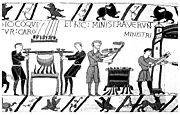
Social status was of the utmost importance during the Middle Ages, and this idea was exemplified through fashion. For example, it was generally understood that scarlet tones, such as red and purple, were important items in the wardrobes of royalty. More specifically, these colours became reserved for Kings and Princes, and denoted luxury and wealth. The medieval sumptuary law
Sumptuary law
Sumptuary laws are laws that attempt to regulate habits of consumption. Black's Law Dictionary defines them as "Laws made for the purpose of restraining luxury or extravagance, particularly against inordinate expenditures in the matter of apparel, food, furniture, etc." Traditionally, they were...
s or “acts of apparel” were put into place to regulate the clothing choices of people during that time. Those who supported the enactment of such laws did so because the laws emphasized the differences between the classes, and clearly defined what those differences are. For example, the 1363 statute to the Clothing Law of 1337 states that wives of yeomen and handicraftsmen may not wear any veil
Veil
A veil is an article of clothing, worn almost exclusively by women, that is intended to cover some part of the head or face.One view is that as a religious item, it is intended to show honor to an object or space...
or kerchief
Kerchief
A kerchief is a triangular or square piece of cloth tied around the head or around the neck for protective or decorative purposes...
made of silk…the higher-status groups, however, are allowed to wear whatever imported items they want. This clearly states the understood division between the rich and poor during this era, and the importance of keeping the classes defined as separate entities. There were rules for every item of clothing; lower class women were banned from wearing expensive veils. Only wives and daughters of wealthy men could wear velvet
Velvet
Velvet is a type of woven tufted fabric in which the cut threads are evenly distributed,with a short dense pile, giving it a distinctive feel.The word 'velvety' is used as an adjective to mean -"smooth like velvet".-Composition:...
or satin
Satin
Satin is a weave that typically has a glossy surface and a dull back. It is a warp-dominated weaving technique that forms a minimum number of interlacings in a fabric. If a fabric is formed with a satin weave using filament fibres such as silk, nylon, or polyester, the corresponding fabric is...
. There was an unfair discontinuity in the rules; lower class citizens could never wear an item designated for the upper class, whereas the upper class could wear anything that suited them. For example, wives and daughters of servants were not to wear veils that cost more than twelve cents.
The English sumptuary acts of 1463 go into explicit detail about clothing items which were reserved for those below the king’s status, putting restrictions on coat length and shoe height. In this legislation, the intention was to prevent men from acting as if they were from a higher class by way of how they dressed. The laws specifically stated that a man was to dress within the status in which he was born. The acts depicted what clothing was to be worn and also clearly stated how the classes were ranked, with kings and royalty at the top and servants at the bottom. Most of these organized lists did not include all groups of people. The majority of the lists consisted of divisions of the upper and middle classes, while the lower classes were neglected altogether. This was because the middle class was considered most likely to violate the clothing laws because they were supposedly most influenced by social pressures, whereas lower class people did not have the capabilities to dress according to a higher ranking even if they desired to do so. In fact, any mention of lower classes was done so out of necessity in order to complete the social hierarchy.
Textiles Used
The most common material used was woolWool
Wool is the textile fiber obtained from sheep and certain other animals, including cashmere from goats, mohair from goats, qiviut from muskoxen, vicuña, alpaca, camel from animals in the camel family, and angora from rabbits....
with the wool ranging in texture and quality based on the type of sheep it came from. The quality could range from the very coarse and undyed for the lower class to extremely fine with designs and colour for the upper class. Linen
Linen
Linen is a textile made from the fibers of the flax plant, Linum usitatissimum. Linen is labor-intensive to manufacture, but when it is made into garments, it is valued for its exceptional coolness and freshness in hot weather....
and hemp
Hemp
Hemp is mostly used as a name for low tetrahydrocannabinol strains of the plant Cannabis sativa, of fiber and/or oilseed varieties. In modern times, hemp has been used for industrial purposes including paper, textiles, biodegradable plastics, construction, health food and fuel with modest...
was another fabric used and was utilized often in the lower class and as undergarments and head coverings. Also, silk
Silk
Silk is a natural protein fiber, some forms of which can be woven into textiles. The best-known type of silk is obtained from the cocoons of the larvae of the mulberry silkworm Bombyx mori reared in captivity...
was a popular material used by the wealthy and was imported from Asia; after the crusades fabrics such as damasks, velvet
Velvet
Velvet is a type of woven tufted fabric in which the cut threads are evenly distributed,with a short dense pile, giving it a distinctive feel.The word 'velvety' is used as an adjective to mean -"smooth like velvet".-Composition:...
s, and satin
Satin
Satin is a weave that typically has a glossy surface and a dull back. It is a warp-dominated weaving technique that forms a minimum number of interlacings in a fabric. If a fabric is formed with a satin weave using filament fibres such as silk, nylon, or polyester, the corresponding fabric is...
were brought back to England, as was samite
Samite
Samite may refer to :* Samite, a heavy silk fabric, of a twill-type weave, worn in the Middle Ages* Samite Mulondo, Ugandan-American musician* SS Samite, a Liberty ship...
. Animal skins were also used such as “sheep-skin cloaks… in winter to keep out the cold and rain”. Leather
Leather
Leather is a durable and flexible material created via the tanning of putrescible animal rawhide and skin, primarily cattlehide. It can be produced through different manufacturing processes, ranging from cottage industry to heavy industry.-Forms:...
was used to produce items such as shoes, belts, gloves and armor.
The middle class could usually afford to dye their wool and colours such as blue and green. The wealthy could afford to add elaborate designs to their clothing as well as dying it red and black, expensive colours for the time. Purple was also considered a colour of royalty and was reserved for kings or religious figures such as the pope
Pope
The Pope is the Bishop of Rome, a position that makes him the leader of the worldwide Catholic Church . In the Catholic Church, the Pope is regarded as the successor of Saint Peter, the Apostle...
.
See also
- EnglandEnglandEngland is a country that is part of the United Kingdom. It shares land borders with Scotland to the north and Wales to the west; the Irish Sea is to the north west, the Celtic Sea to the south west, with the North Sea to the east and the English Channel to the south separating it from continental...
- 1100–1200 in fashion
- 1200–1300 in fashion
- 1300–1400 in fashion
- Anglo-Saxon dressAnglo-Saxon dressAnglo-Saxon dress refers to the variety of early medieval European dress, or clothing, worn by the Anglo-Saxons from the time of their migration to Great Britain in the 5th century until the beginning of the Norman Conquest, when Norman fashions from the Continent began to have a major influence in...
- History of clothing and textilesHistory of clothing and textilesThe wearing of clothing is exclusively a human characteristic and is a feature of most human societies. It is not known when humans began wearing clothes...
- Early Middle AgesEarly Middle AgesThe Early Middle Ages was the period of European history lasting from the 5th century to approximately 1000. The Early Middle Ages followed the decline of the Western Roman Empire and preceded the High Middle Ages...
- High Middle AgesHigh Middle AgesThe High Middle Ages was the period of European history around the 11th, 12th, and 13th centuries . The High Middle Ages were preceded by the Early Middle Ages and followed by the Late Middle Ages, which by convention end around 1500....
- Early medieval European dressEarly medieval European dressEarly medieval European dress changed very gradually from about 400 to 1100. The main feature of the period was the meeting of late Roman costume with that of the invading peoples who moved into Europe over this period...
External links
- http://www.britishmuseum.org/explore/world_cultures/europe/medieval_europe.aspx
- http://www.medieval-spell.com/Medieval-Fashion.html
- http://www.middle-ages.org.uk/medieval-fashion.htm
- http://www.yesnet.yk.ca/schools/projects/middleages2000/fashion/fashion.html

